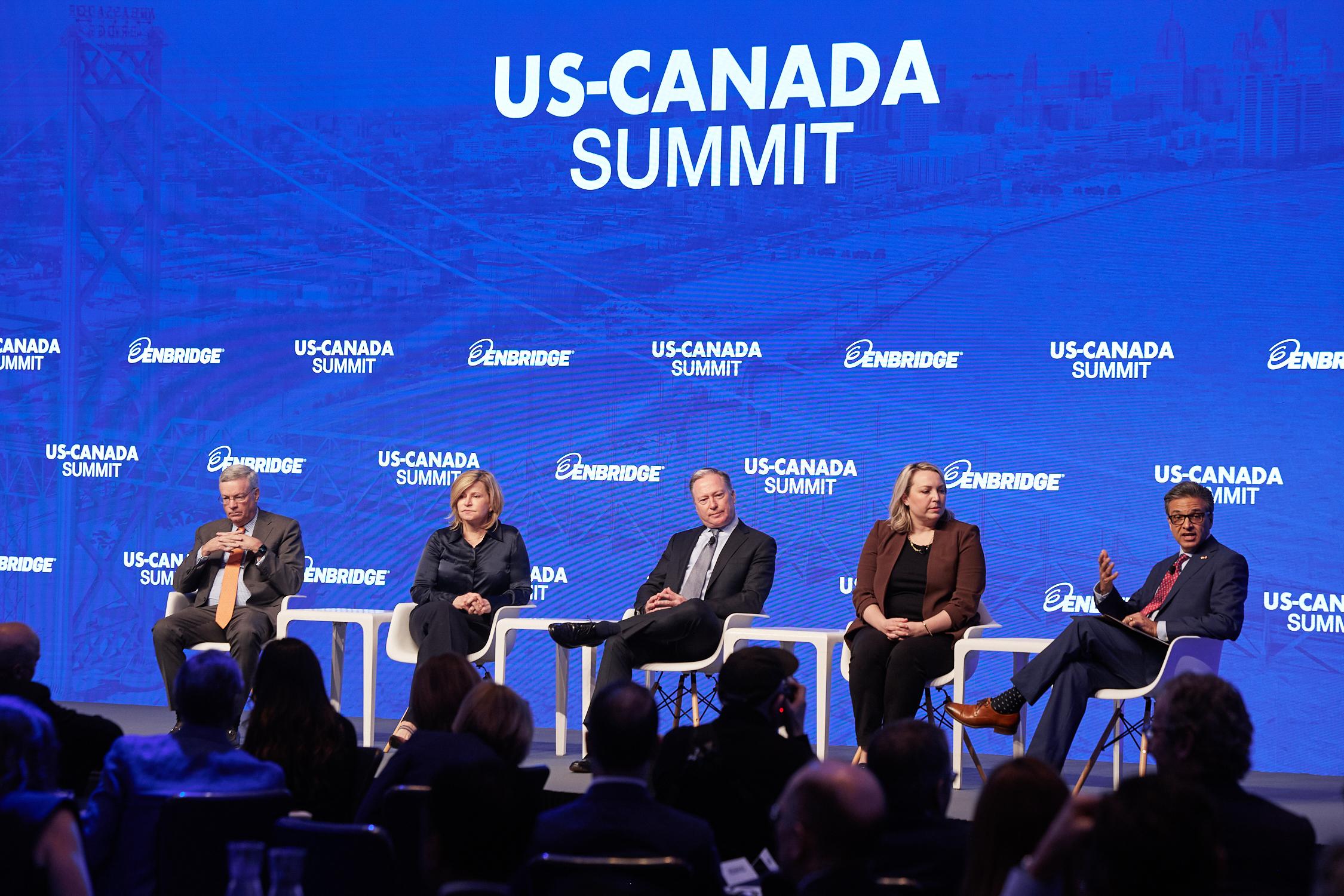For all the challenges that volley back and forth across the Canada-U.S. border, the central question being asked by the private sector is whether North America’s infrastructure can handle the evolving demands of the 21st century.
Goldy Hyder, President and CEO of the Business Council of Canada, moderated the panel, Private-Sector Perspectives – Redesigning North America’s Infrastructure to Boost Connectivity, which featured an elite group of North American business leaders at the inaugural US-Canada Summit on April 4, hosted by BMO and the Eurasia Group. Alfred F. Kelly, Jr., Executive Chairman of Visa, and Frances Donald, Global Chief Economist at Manulife, led a discussion around the challenges facing the financial sector and the broader economy, while Greg Ebel, President and CEO of Enbridge, and Tracy Robinson, President and CEO of Canadian National (CN), spoke to the challenges holding back Canadian industry.
Despite all serving different parts of the economy, the panel agreed that the energy transition and an interconnected economy means that North American infrastructure and its regulatory environment – financial, environmental, communications and more – must be modernized to keep pace.
With the massive investment required for the energy transition there’s a need for integrated policies, explained Goldy Hyder at the opening of the session. The focus of all levels of government must be on building out infrastructure to create a competitive North American market, he said.
A Changing Economy
With many distracted by the prospects of a looming recession and an economy beset by labour shortages and falling productivity, Manulife’s Frances Donald believes the real challenges facing the North American economy are more structural.
She noted that the transition toward an environmental, social and governance (ESG)-driven economy from one that was previously focused on globalization presents an opportunity to address employment and productivity challenges across North America. “The solution to all of these major modern problems is infrastructure,” Donald noted.
Each sector faces infrastructure challenges, from broadband access, to gaps in our transportation systems to get goods and energy production to markets. But it’s not just a matter of laying wires, rails, or pipelines. There was broad consensus on the panel that the political infrastructure must also be reinvigorated.
Greater Geopolitical Alignment
Pointing to policy changes in the U.S. to allow the export of natural gas, and Germany’s pivot to start construction of a liquefied natural gas (LNG) import facility, Enbridge’s Greg Ebel noted that Canada still lacks the infrastructure to ship natural gas. The reason? Not enough alignment between political leaders, he explained.
Those barriers are not only holding the economy back, but they’re also preventing clean energy from reaching markets that need it, which slows down the energy transition, he said. “The West Coast of Canada has the ability to move LNG, the cleanest energy in the world to different parts of the world,” noted Ebel. “Yet we’re focused here on the one and a half percent of emissions that we have.”
“Unless we get the permitting right, we’re not going to get to this position where we can take advantage of the advantages we have,” he explained.
With CN focused on trying to find efficiencies in a strained global supply chain, Tracy Robinson shares the view that the international community needs to be more coordinated. “We need to be working together both in the planning and the execution,” said Robinson, who noted that the supply chain needs to move away from operating in silos to becoming more integrated on a global scale.
Apart from the challenge in physical infrastructure, gaps in digital infrastructure need to be addressed, too. While Canada and the U.S. rank high globally for access to the internet, large systemic gaps remain, said Visa’s Alfred F. Kelly, Jr. For instance, in the U.S., 40 percent of Black households don’t have access to high-speed internet. In Canada, only 43 percent of First Nations have access to broadband internet. “Clearly there is more work to do,” he said.
Getting that connectivity in place is important to companies like Visa, as smartphones increasingly serve as point-of-sale devices. “We have to continue to work on resilience,” he said. “To show you that we’re an infrastructure business, we have 10 million miles of fibre around the world and every Visa transaction could rally 20 different ways because we use three different systems or four data centres.”
Reforming the Regulatory Environment
As eager as the industry is to help build out all of this infrastructure, the panel argued that progress is being stymied by regulation. “It takes five, seven, eight years to build a manufacturing plant,” noted Kelly, Jr. “It’s crazy.” Regulation, he added, is the single biggest issue Washington should focus on resolving.
“If we’re going to be more competitive, we have to improve our ability to move forward with all the regulatory nonsense that gets in the way of making progress,” he said.
Consistency is also critical, added Donald. “We have to know the rules can’t change. And we need to start moving really, really quickly.”
Captured in photo (L-R):
Alfred F. Kelly, Jr., Executive Chairman of Visa
Tracy Robinson, President and CEO of Canadian National (CN)
Greg Ebel, President and CEO of Enbridge
Frances Donald, Global Chief Economist at Manulife
Goldy Hyder, President and CEO of the Business Council of Canada
